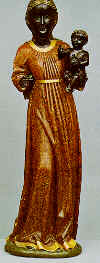Einsiedeln Black Madonna
Einsiedeln Black Madonna
Our Lady of Einsiedeln
— Michael P. Duricy
The story of Our Lady of the Hermitage in Einsiedeln, Switzerland, begins in the days of Blessed Meinrad (d. 861). In 853, while living in seclusion near a small lake, the holy man had a small chapel built near his cell and therein placed a statue of the Blessed Virgin with the Infant resting on her arm. This statue had been given to him by the Abbess Hildegard, Superior of a convent in Zurich.
In 948, after a church had been built on the site of Meinrad's little cell and chapel, just before the ecclesial dedication ceremony for the building, Our Lord miraculously appeared and was seen to perform the Mass of Consecration. When Bishop Conrad of Constance arrived for the service an unknown voice was heard to say: "Stop, brother, the church has been consecrated by God." Charles Broschart notes a resemblance between these miraculous events and those surrounding the church of Our Lady of Puy, France in the fifth century.
As if these events were not miraculous enough, note that the church and monastery have been damaged by fire several times over the course of centuries, but the statue has been unharmed. In fact: in each of the five fires which reduced the church to ashes, only the holy chapel containing the miraculous image escaped injury.
In addition to these miraculous origins:
Throughout the centuries, miracles of every nature have been performed through the intercession of Our Lady of Einsiedeln; but the shrine claims as the most striking those graces which have invigorated faith and devotion. It is no miracle then, that Einsiedeln is today, and has been for centuries, the home of one of the most famous Catholic shrines of the Blessed Virgin. However, in contrast to the shrine of Our Lady at Czestochowa, its popularity is limited mainly to Switzerland, Germany and Austria.

In Broschart's opinion, the present statue is not Meinrad's original. He writes:
It is thought that the present statue, known as the Black Madonna, was carved in 1466, after the third major fire, probably in Northern Switzerland or Southern Germany. It is a little under four feet in height.
Why Is She Black?
To the question: 'Why is the image black?', Broschart opines: "over the years the faces of the Virgin and Child have been darkened by the smoke and fumes of votive candles." Though this explanation is overused, in this case it seems correct. Ean Begg notes that the image was cleaned during its flight from iconoclasts inspired by the French revolution. It was intentionally darkened before public display was resumed, perhaps catering to nostalgic sentiment.
The image was returned to its shrine in 1803 and remains there to this day, still attracting pilgrims. Among these were a number of "royal and other illustrious personages," including three canonized Saints, Charles Borromeo, Benedict Joseph Labre; and, of course, the Patron Saint of Switzerland, Nicholas of Flue [also called 'Brother Klaus'].
For further information on Our Lady of Einsiedeln, refer to The Cult of the Black Virgin (1985) by Ean Begg; Miraculous Images of Our Lady (1993) by Joan Carroll Cruz; and Call Her Blessed (1961) by Charles B. Broschart.
All About Mary includes a variety of content, much of which reflects the expertise, interpretations and opinions of the individual authors and not necessarily of the Marian Library or the University of Dayton. Please share feedback or suggestions with marianlibrary@udayton.edu.
